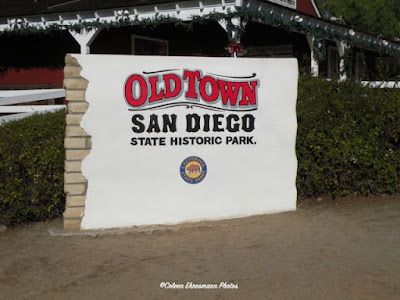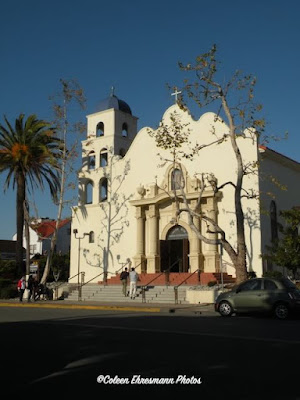We are staying in Old Town San Diego and are just one block from Old Town State Historical Park.
The park pays tribute to the cultural influences that make California special. Restored and reconstructed buildings in Old Town San Diego State Historical Park are now museums, shops and restaurants that capture the energy of the community between 1821 and 1872.
First, we visited an Interpretive Center of the Kumeyaay people who lived on the San Diego River.
For thousands of years, the people migrated between ocean and mountains-gathering seafood, acorns, and necessities of life. At first, the Spanish settlers were welcomed by the Kumeyaay, but devastating challenges to traditional ways increasingly affected their lives. Kumeyaay culture proved resilient and today many Kumeyaay proudly continue their traditions with modern adaptations.
Geocaching brought us to the park and laid the foundation for our exploration of Old Town San Diego State Historical Park.
James Robinson built this two-story structure in 1853 as his family residence and law office. The reconstructed building now serves as the park's visitors center. It sits across from the Plaza de Las Armas which hosted festivities, such as fiestas, bullfights, games of chance, and other amusements that offered opportunities for gambling.
The house is known as the Robinson-Rose house. It took some research as to how a Jewish immigrant and entrepreneur from Germany, Louis Rose, was connected to the house. Robinson's widow sold the house to Rose in 1868 for $10,000 in gold coins. Mr. Rose organized the first Jewish community in San Diego. He was also a large land owner, started the community of Roseville which became part of New Town San Diego, was post master of Old Town for 10 years and served on the San Diego School Board. (Rose traveled to CA from TX with James Robinson. So they knew each other.)
The Robinson-Rose house was demolished in 1900 and rebuilt in 1998.
The chimney of what was probably the kitchen or cook house is an interesting shape. The structure has two chimneys; one for cooking and one for heating the building.
First San Diego Courthouse
It was originally designed as a town hall when it was constructed in 1847. It was the first brick building. On March 27, 1850, the state legislature incorporated the town of San Diego. From that time until 1869, the building served as the city and county courthouse.
The Colorado House, next door, was originally a hotel. Today it is home to the Wells Fargo History Museum.
La Casa de Estudillo
Large is an understatement! This home sits at the opposite end of the Plaza de las Armas and covers the the street block from end to end. The house built in 1829 in a U shape around a large garden. Today it is a museum.
Casa de Estudillo is one of the oldest surviving examples of a typical Spanish-Mexican town house in California.
In 1867 Franciscan Alonzo Horton arrived from San Francisco and began building in New Town. New Town quickly eclipsed the older settlement. The Government buildings moved to the new community taking along much of Old Town's economic base. A fire in the spring of 1872 destroyed seven buildings including the old courthouse.
In 1907 John D. Spreckels (son of sugar magnate Claus Spreckels) purchased the La Casa de Estudillo and began efforts to revive Old Town San Diego.
Cosmopolitan Hotel and Restaurant
Casa de Bandini was built in 1829 by Juan Bandini, an Italian immigrant from Peru, who migrated to this historic community in California later know as “Old Town”.
The home he built was first a one-story adobe home where he raised his family, entertained and held community political meetings. He liked to gamble and unfortunately, to settle a large gambling debt, he lost his home to the owner of a new stagecoach line. This new owner added a second story
to the building to create a hotel for his stagecoach passengers. Later the stagecoaches were replaced with motorized vehicles and the hotel became an active destination in the red light district of the community. It later became a rooming house and then eventually back to a hotel by the name of the Cosmopolitan Hotel and then the Miramar Hotel. After that it was vacated for several years until I revitalized it in 1980 to the Casa de Bandini restaurant. ~ The History of Casa de Bandini by Diane Powers
Seeley Stables
Albert Seeley operated a thriving stagecoach line between San Diego and Los Angeles from 1868 to 1874. The barn has been reconstructed and now houses vintage carriages and transportation memorabilia. It is also home to Old Town's resident burros...which we did not see. There is a working black smith shop behind the stables.
Whaley House
Built in 1857 by Thomas Whaley as his family residence, a commercial theater, the county courthouse, and the Whaley and Crosthwaite General Store. The house was built on the site of the hanging of the infamous Yankee Jim Robinson. It is said Yankee Jim's ghost, among others has long been rumored to haunt the Whaley House.
El Campo Santo Cemetery is the second oldest San Diego cemetery, established in 1849. It is the final resting place for 477 people.
During the falling of the Old Town period, the cemetery was abandoned. In 1889 a streetcar line was built through the graveyard. Later the street and sidewalk were paved over portions of the cemetery covering about 20 graves. In 1933 the San Diego Historical Society restored the cemetery building an adobe wall around it. Radar was used to discover some underground gravesites in 1993.
Five of the above buildings and locations were part of a geocaching adventure giving us a great experience with the history of Old Town San Diego.
Immaculate Conception celebrated its 100th anniversary in 2019. Rev. John Holbein was the first resident pastor in San Diego in July 1849. An adobe structure was built and named Immaculate Conception of the Most Blessed Virgin.
The cornerstone for this church was first laid in July 1868, but the economic decline of Old Town and the fire of 1872 delayed the construction until 1914.
In 1998, the church was seismically retrofitted to withstand earthquakes and it was rededicated by Bishop Gilbert E. Chavez. On July 14, 2019, the parish celebrated the 100th Anniversary of the Dedication of Immaculate Conception Church with a Mass officiated by Bishop John P. Dolan. It now serves over 300 families throughout the San Diego region as well as visitors from around the world.
The bell tower houses one of the two original bells from the San Diego Mission.
the Pepper Tree
There were many Pepper Trees along the sidewalks in Old Town where we walked today, including in the cemetery.
Casa de Aguirre
now a museum and marketplace
Don José Antonio Aguirre (1799-1860) was a wealthy merchant. He built one of the first Old Town adobe mansions on this site in 1853. He contributed much to the growth and development of San Diego. He owned several ships and warehouses, importing goods from Peru and China and exporting cowhides and tallow. He developed a successful ranching operation and became one of the largest landowners in California. He was one of the founders of New Town San Diego.
























No comments:
Post a Comment
Thanks for your comments!